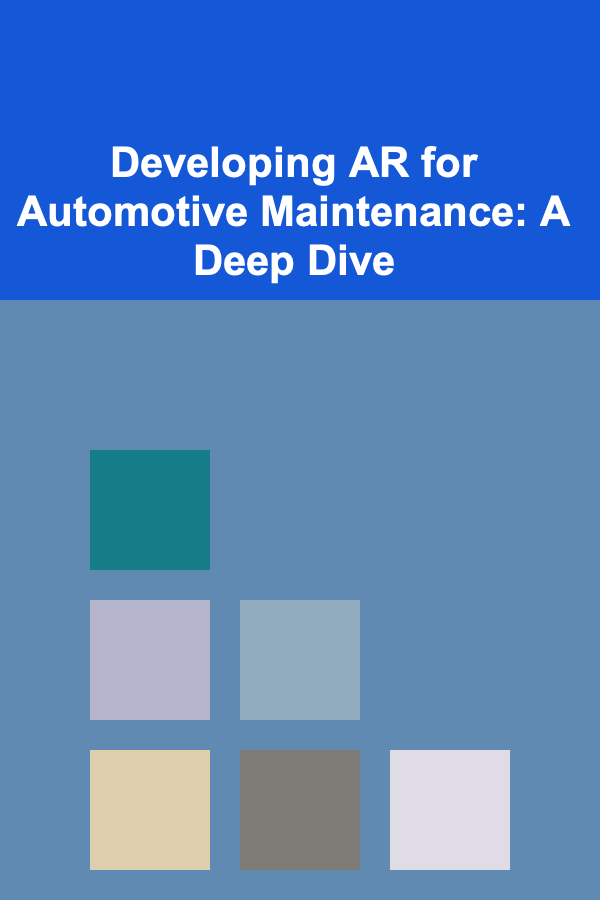
Developing AR for Automotive Maintenance: A Deep Dive
ebook include PDF & Audio bundle (Micro Guide)
$12.99$9.99
Limited Time Offer! Order within the next:

Introduction: The Augmented Revolution in Automotive Repair
The automotive maintenance industry is on the cusp of a technological revolution, driven by the transformative power of Augmented Reality (AR). AR, unlike Virtual Reality (VR), overlays digital information onto the real world, providing users with context-aware guidance and assistance. This technology holds immense potential to enhance the efficiency, accuracy, and accessibility of automotive maintenance procedures, benefiting both seasoned mechanics and DIY enthusiasts.
Traditionally, automotive maintenance relies heavily on physical manuals, diagnostic tools, and the mechanic's accumulated experience. This approach can be time-consuming, prone to errors, and challenging to scale, especially with the increasing complexity of modern vehicles. AR addresses these challenges by providing mechanics with real-time, interactive guidance directly within their field of view, streamlining workflows and reducing the likelihood of mistakes.
This article delves into the intricacies of developing AR applications for automotive maintenance, exploring the key technologies, development processes, potential challenges, and future directions. We will examine the benefits, discuss specific use cases, and provide practical insights for developers and businesses looking to leverage the power of AR in this dynamic industry.
Benefits of AR in Automotive Maintenance
The adoption of AR in automotive maintenance offers a multitude of advantages, contributing to improved efficiency, enhanced accuracy, and reduced costs. These benefits can be broadly categorized as follows:
- Improved Efficiency: AR guides mechanics through complex procedures step-by-step, eliminating the need to constantly refer to manuals or diagrams. This reduces downtime and allows mechanics to complete tasks more quickly and efficiently.
- Enhanced Accuracy: By overlaying visual instructions directly onto the vehicle's components, AR minimizes the risk of errors and ensures that procedures are performed correctly. This is particularly crucial when dealing with intricate systems or components that require precise adjustments.
- Reduced Training Time: AR can be used to train new mechanics quickly and effectively by providing them with immersive, hands-on experience. Simulated scenarios and interactive tutorials can accelerate the learning process and equip trainees with the skills they need to perform real-world tasks.
- Remote Assistance and Collaboration: AR enables remote experts to provide real-time guidance to mechanics in the field, even when they are geographically separated. This can be invaluable for troubleshooting complex problems or performing specialized repairs.
- Increased Accessibility for DIYers: AR apps can empower DIY enthusiasts to perform basic maintenance tasks safely and confidently, providing them with the knowledge and guidance they need to keep their vehicles in good condition.
- Improved Documentation and Reporting: AR applications can automatically record maintenance procedures and generate detailed reports, providing valuable data for quality control and future reference.
- Enhanced Customer Satisfaction: By providing transparent and efficient service, AR can improve customer satisfaction and build trust in the automotive maintenance provider.
Key Technologies and Platforms for AR Development
Developing AR applications for automotive maintenance requires a careful selection of technologies and platforms. The choice depends on factors such as the target audience, the complexity of the application, and the budget available.
AR Platforms and Frameworks
- ARKit (Apple): ARKit is Apple's AR platform, designed for iOS devices. It provides robust features for tracking and scene understanding, enabling developers to create immersive and realistic AR experiences. ARKit's strengths include its ease of use, its wide adoption among iOS users, and its integration with Apple's ecosystem.
- ARCore (Google): ARCore is Google's AR platform, supporting Android devices and also available on iOS. It offers similar functionalities to ARKit, including motion tracking, environmental understanding, and light estimation. ARCore's cross-platform compatibility makes it a popular choice for developers targeting a broad audience.
- Vuforia Engine: Vuforia is a cross-platform AR SDK that supports both image-based and object-based tracking. It is widely used in industrial applications and offers advanced features such as model targets and area targets. Vuforia is a commercial SDK but offers a free version for non-commercial use.
- Unity and Unreal Engine: These are popular game engines that also serve as powerful platforms for AR development. They provide a wide range of tools and features for creating interactive 3D content and integrating it with AR tracking libraries. Unity and Unreal Engine are well-suited for complex AR applications that require high levels of visual fidelity and interactivity.
Hardware Considerations
- Mobile Devices (Smartphones and Tablets): These are the most common platforms for delivering AR experiences. Modern smartphones and tablets are equipped with powerful processors, high-resolution cameras, and sensors that enable accurate AR tracking.
- Head-Mounted Displays (HMDs): HMDs, such as Microsoft HoloLens and Magic Leap, offer a more immersive and hands-free AR experience. They are particularly well-suited for complex maintenance tasks that require the mechanic to have both hands free. However, HMDs are typically more expensive than mobile devices.
- Augmented Reality Glasses: AR glasses offer a more discreet and comfortable AR experience compared to HMDs. While the technology is still evolving, AR glasses have the potential to become a popular platform for automotive maintenance in the future.
Software and Tools
- 3D Modeling Software: Software like Blender, Maya, or 3ds Max is used to create 3D models of vehicle components. These models are essential for overlaying virtual information onto the real world.
- CAD Software: CAD data, often available from vehicle manufacturers, can be used to create accurate 3D models for AR applications.
- Image Recognition Libraries: Libraries like OpenCV can be used to recognize specific parts of the vehicle, triggering the display of relevant AR information.
- Data Management Systems: A robust data management system is needed to store and manage the vast amounts of data associated with vehicle maintenance, including repair procedures, parts information, and diagnostic data.
- Version Control Systems (e.g., Git): Essential for collaborative development and managing code changes.
The Development Process: A Step-by-Step Guide
Developing an AR application for automotive maintenance is a complex process that requires careful planning and execution. The following steps outline a typical development workflow:
- Define the Scope and Objectives: Clearly define the purpose of the AR application. What specific maintenance tasks will it support? What are the desired outcomes (e.g., reduced repair time, improved accuracy)? Identify the target users and their specific needs.
- Gather Requirements: Conduct user research to understand the needs and pain points of mechanics. Gather information about the specific vehicles and maintenance procedures that the application will support. Identify any regulatory or safety requirements that must be met.
- Design the User Interface (UI) and User Experience (UX): Design a user-friendly and intuitive interface that is easy to navigate and understand. Consider the context in which the application will be used (e.g., in a dimly lit garage). Ensure that the AR overlays are clear, accurate, and non-obtrusive. Prioritize a hands-free experience whenever possible.
- Create 3D Models and Content: Develop accurate 3D models of vehicle components. Create animations and interactive elements to guide mechanics through maintenance procedures. Integrate relevant data, such as repair manuals, diagnostic information, and parts lists. Optimize the models for performance, ensuring that they load quickly and run smoothly on the target devices.
- Develop the AR Application: Choose an appropriate AR platform and framework (e.g., ARKit, ARCore, Vuforia). Implement the tracking and scene understanding functionalities. Integrate the 3D models and content into the AR environment. Develop the user interface and implement the interaction logic. Ensure that the application is robust and handles errors gracefully.
- Test and Iterate: Thoroughly test the AR application in real-world scenarios. Gather feedback from mechanics and other stakeholders. Iterate on the design and implementation based on the feedback received. Pay close attention to performance, accuracy, and usability. Conduct usability testing to identify any areas that need improvement.
- Deploy and Maintain: Deploy the AR application to the target devices. Provide ongoing support and maintenance. Regularly update the application with new features and bug fixes. Monitor user feedback and usage data to identify areas for improvement. Consider a phased rollout to a small group of users before deploying to a wider audience.
- Integrate with Existing Systems: Integrate the AR application with existing maintenance management systems, parts databases, and diagnostic tools. This can streamline workflows and improve data accuracy. Consider APIs for seamless data exchange.
Specific Use Cases for AR in Automotive Maintenance
The potential applications of AR in automotive maintenance are vast and varied. Here are some specific examples:
- Step-by-Step Repair Guides: AR can overlay step-by-step instructions directly onto the vehicle, guiding mechanics through complex repair procedures. This can significantly reduce repair time and improve accuracy.
- Diagnostic Assistance: AR can display diagnostic data in real-time, helping mechanics to identify the root cause of problems more quickly. AR can highlight faulty components, display sensor readings, and provide access to relevant technical documentation.
- Parts Identification and Ordering: AR can be used to identify specific parts and order replacements directly from the application. By scanning a component, mechanics can access its part number, availability, and price.
- Wiring Diagram Overlays: AR can overlay wiring diagrams onto the vehicle's electrical system, making it easier for mechanics to trace wires and identify connections. This can be particularly helpful when troubleshooting electrical problems.
- Fluid Level Checks: AR can guide mechanics through the process of checking fluid levels, displaying the correct levels and indicating where to add fluid.
- Torque Specifications: AR can display torque specifications for bolts and fasteners, ensuring that they are tightened to the correct level. This is critical for safety and performance.
- Remote Expert Assistance: A junior mechanic can use an AR application to stream video of a repair issue to a remote expert who can then annotate the live video with instructions and guidance. This allows for real-time problem solving and knowledge transfer.
- Training and Education: AR can be used to train new mechanics in a safe and engaging environment. Simulated scenarios and interactive tutorials can accelerate the learning process and improve retention.
Example Scenario: Brake Pad Replacement
Imagine a mechanic using an AR application to replace brake pads. The application overlays step-by-step instructions directly onto the brake system. The mechanic is guided through the removal of the wheel, the removal of the brake caliper, the replacement of the brake pads, and the reassembly of the system. The application displays torque specifications for the caliper bolts and provides visual cues to ensure that all components are installed correctly. If the mechanic encounters a problem, they can use the application to access relevant technical documentation or connect with a remote expert for assistance.
Challenges and Considerations
While AR offers significant potential for automotive maintenance, there are also several challenges and considerations that must be addressed during development and deployment:
- Accuracy and Reliability of Tracking: Accurate and reliable tracking is essential for providing a seamless AR experience. Factors such as lighting conditions, occlusions, and rapid movements can affect tracking performance. It is important to choose tracking technologies that are robust and can handle a variety of challenging conditions.
- Computational Power and Battery Life: AR applications can be computationally intensive, requiring significant processing power and battery life. It is important to optimize the application for performance and minimize battery consumption. Consider using edge computing to offload some of the processing burden to a remote server.
- Data Acquisition and Management: Developing AR applications for automotive maintenance requires access to a vast amount of data, including 3D models, repair manuals, diagnostic information, and parts lists. Acquiring and managing this data can be a significant challenge. Collaboration with vehicle manufacturers and aftermarket suppliers is essential.
- User Acceptance and Training: Mechanics may be resistant to adopting new technologies, particularly if they are perceived as being complex or difficult to use. It is important to provide adequate training and support to ensure that mechanics are comfortable using the AR application. Involve mechanics in the development process to ensure that the application meets their needs.
- Security and Privacy: AR applications may collect sensitive data, such as location information and repair records. It is important to implement appropriate security measures to protect this data from unauthorized access. Comply with all relevant privacy regulations.
- Cost of Development and Deployment: Developing and deploying AR applications can be expensive, requiring significant investment in hardware, software, and development resources. It is important to carefully evaluate the costs and benefits before embarking on an AR project.
- Integration with Existing Workflows: Seamlessly integrating AR into existing maintenance workflows is crucial for successful adoption. The AR system should complement, not complicate, current practices.
- Environmental Considerations: Garages can be harsh environments with dust, grease, and potential hazards. AR hardware needs to be robust and designed to withstand these conditions. Safety considerations are paramount.
The Future of AR in Automotive Maintenance
The future of AR in automotive maintenance is bright. As AR technology continues to evolve, we can expect to see even more sophisticated and innovative applications emerge. Some potential future developments include:
- AI-Powered AR: Integrating Artificial Intelligence (AI) with AR can enable more intelligent and adaptive maintenance solutions. AI can be used to analyze diagnostic data, predict potential problems, and provide personalized guidance to mechanics.
- Predictive Maintenance: AR can be used to visualize predictive maintenance data, helping mechanics to identify potential problems before they occur. This can prevent costly breakdowns and improve vehicle uptime.
- Holographic AR: Holographic AR, which projects 3D images into the real world, can provide a more immersive and realistic AR experience. This can be particularly helpful for visualizing complex systems and procedures.
- Collaboration with Vehicle Manufacturers: Closer collaboration with vehicle manufacturers can lead to the development of more integrated and effective AR maintenance solutions. Manufacturers can provide access to CAD data, repair manuals, and diagnostic information, enabling developers to create more accurate and comprehensive AR applications.
- AR-Enabled Self-Service: As AR technology becomes more accessible, we may see the emergence of AR-enabled self-service kiosks in auto parts stores and service centers, allowing customers to diagnose and troubleshoot their own vehicle problems.
- AR-Enhanced Vehicle Design and Manufacturing: The principles of AR assistance can be applied upstream in the vehicle design and manufacturing process. Designers can use AR to visualize how a vehicle will be maintained and repaired, leading to more maintainable designs.
In conclusion, AR holds immense potential to transform the automotive maintenance industry. By providing mechanics with real-time, interactive guidance and assistance, AR can improve efficiency, enhance accuracy, and reduce costs. While there are challenges to overcome, the benefits of AR are clear, and the technology is poised to play an increasingly important role in the future of automotive maintenance. As the technology matures and becomes more affordable, its adoption will only accelerate, ushering in a new era of augmented automotive expertise.

How to Celebrate Financial Milestones Without Overspending
Read More
How to Evaluate and Adjust Your Seasonal Strategies Annually
Read More
How to Sell Greeting Cards at Local Markets and Craft Fairs: An Actionable Guide
Read More
How to Use Baskets for Quick Toy Cleanup
Read More
How to Utilize ChatGPT for Business Plan Drafting
Read More
10 Strategies for Promoting a Positive Safety Culture
Read MoreOther Products

How to Celebrate Financial Milestones Without Overspending
Read More
How to Evaluate and Adjust Your Seasonal Strategies Annually
Read More
How to Sell Greeting Cards at Local Markets and Craft Fairs: An Actionable Guide
Read More
How to Use Baskets for Quick Toy Cleanup
Read More
How to Utilize ChatGPT for Business Plan Drafting
Read More